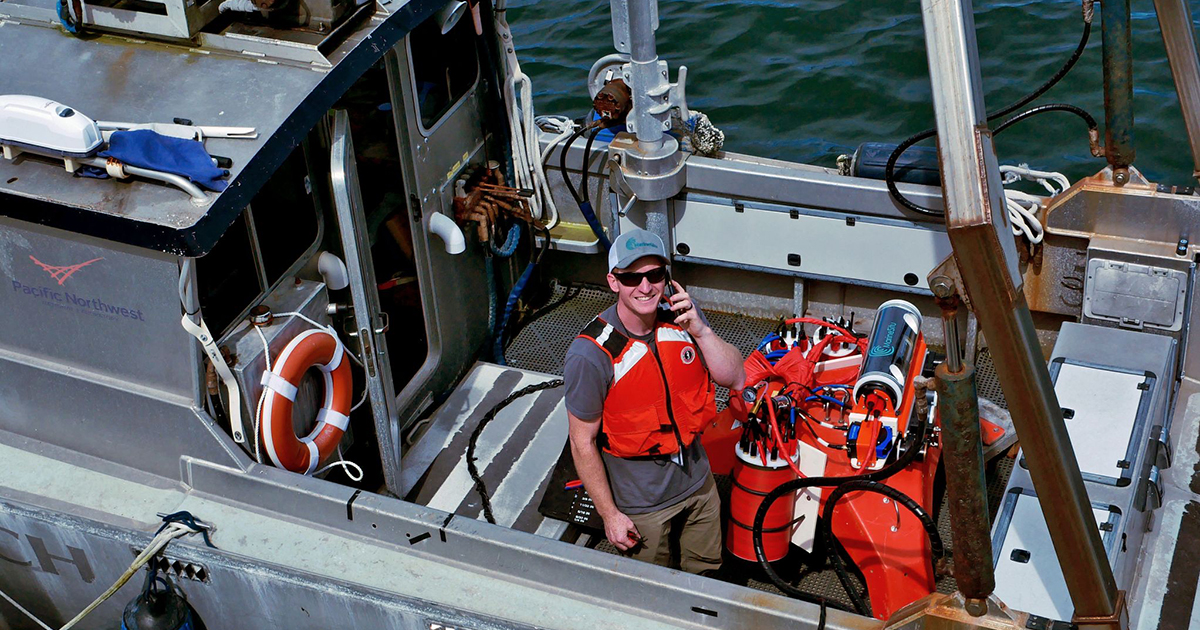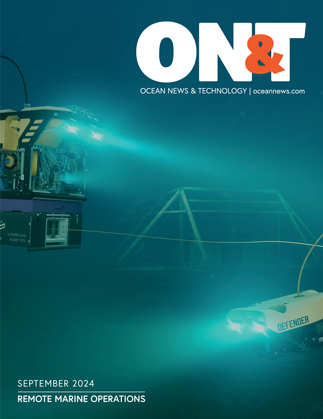Supported by the US Department of Energy and directed by the Pacific Ocean Energy Trust, TEAMER accelerates the viability of marine renewables by providing access to the nation’s best facilities and expertise to solve critical challenges, build knowledge, foster innovation, and drive commercialization.
The following projects have been selected to proceed:
Bluewater Network LLC
Rapid and cost-effective assessment of the feasibility of wave energy to support resilient desalination and power on San Nicholas Island, California
Facility: Integral Consulting Inc.
To date, operational green energy-powered desalination systems have not been deployed in the US despite numerous opportunities. A primary barrier to marine renewable energy (MRE) support for a desalination system is the cost of identifying and siting commercially viable deployment sites. The deployment of a well-sited, small-scale wave energy converter (WEC) array can support a remote community, such as the one found on San Nicholas Island (SNI), California, and its need for a green energy-powered freshwater supply. Bluewater Network (BWN), with the Department of Defense (DoD), is evaluating the feasibility of a WEC array that supports SNI’s needs. Integral Consulting Inc. will conduct a desktop feasibility assessment for developing a WEC array that supports the island’s local community and DoD renewable energy needs.
C-Power
Overvoltage Protection of Direct Drive Wave Power System (WPS) Electrical Components
Facility: Cardinal Engineering
This project will investigate and characterize protection systems for hydrodynamically induced, transient overvoltage events in a utility-scale wave power system (WPS) with a direct drive, permanent magnet generator. A successful design will minimize power generation downtime and efficiency losses, while cost-effectively protecting electrical components from transient overvoltage events. Metrics used to evaluate impact include annual power performance, capital expense impact, overvoltage protection system reliability, and power production availability, all assessed with respect to the WPS baseline design. The results of this investigation are intended to both improve C-Power’s StingRAY WPS and benefit overvoltage protection design for the greater marine energy industry.
Crown Estate Scotland
Investigating Tidal current Energy inter-array Impacts and uncertainties for Real Projects (ITEIRP)
Facility: Sandia National Laboratories
The project explores tidal turbine inter-array interactions. Crown Estate Scotland (CES), with Sandia National Laboratories (SNL), will develop integrated hydrokinetic and coastal hydrodynamic models of Scotland’s Pentland Firth and Orkney Waters (PFOW) using SNL-Delft3D-CEC. SNL-Delft3D-CEC has accurately represented changes in turbulent kinetic energy and dissipation rates due to current energy converter (CEC) activity (in small-scale flume test data). This study further tests the CEC module within SNL-Delft3D-CEC against field measurements around full-scale CEC devices, and will utilize real-world CEC parameters. The studies will advance CES and global understanding of inter-array effects. The outcomes will assist CES in developing leasing plans, provide CES with baseline numerical models to assess the inter-array effects, and enhance CES’s understanding of SNL-Delft3D-CEC capabilities and its potential advantages over other tools.
Deep Anchor Solutions Inc.
Optimizing Corrosion Allowance and Fatigue Performance of Deeply Embedded Ring Anchor for Floating Marine Renewable Energy
Facility: Stress Engineering Services Inc.
This research initiative, led by Stress Engineering Services and Deep Anchor Solutions, aims to enhance deeply embedded ring anchor (DERA) technology. The six-task program focuses on refining DERA designs, specifically addressing challenges in severe offshore environments. By improving the durability and integrity of the DERA, the research aligns with the shared goal of advancing the blue economy by reducing the Levelized Cost of Energy (LCOE) for sustainable marine renewable energy solutions. Tasks, such as corrosion and fatigue evaluations, provide a basis for optimal anchor design, improving performance over the project life, contributing to the resilience and efficiency of marine energy facilities. The project’s success holds promise for significant strides in marine renewable energy technology, fostering economic sustainability and environmental resilience within the blue economy.
Hawaii Ocean Power Solutions
New Technology Qualification for Halona WEC pilot demonstrations
Facility: American Bureau of Shipping (ABS)
Hawaii Ocean Power Solutions is requesting support preparing for pilot demonstrations of Halona WEC. This project seeks to review previous work around Halona WEC for new technology qualification, assess the manufacturing of a pilot demonstration model, and issue a letter of maturity. In preparing for the pilot demonstration, a review of designs and manufacturing will be conducted to ensure our technology complies with IEC and ABS standards. This project provides HOPS with access to expertise needed to ensure a robust pilot demonstration in Hawaii, while creating a pathway for other WEC developers to follow.
Littoral Power Systems, Inc.
Evaluating the feasibility of tidal energy extraction at non-operational gas platforms and effects of sedimentation and sea ice in Cook Inlet
Facility: Pacific Northwest National Laboratory
In April 2024, Littoral Power Systems, Inc. [LPS] was granted FERC preliminary permit P-15317 for the Upper Cook Inlet Tidal Energy Project [UCITEP]. This permit covers a project area adjacent to Middle Ground Shoal in Cook Inlet, AK. The project boundary encompasses four existing non-producing natural gas platforms. LPS plans to study the bounded area for the feasibility of a 2-8 MW tidal energy project. The proposed study will provide unique modeling including: (i) current velocity and turbulence, taking into account the effect of the four platforms, (ii) distribution of ice growlers (i.e., submersed small icebergs often carrying embedded boulders), that could substantially damage a mid-water-column turbine, and (iii) likelihood of seabed motion through an analysis of shear stresses in the seabed near the towers.generation.
Orbital Marine Power
Site identification framework and environmental compliance for floating ocean current turbines in US waters
Facilities: Pacific Northwest National Laboratory, Florida Atlantic University
At present there are no consistent frameworks to enable site selection and to attain legal and social acceptance for floating ocean current turbines in the USA. The lack of framework can lead to costly development expenditures on projects that do progress due to regulatory issues. This project will follow the previous techno economic analysis completed by Orbital looking at augmentation of the existing tidal technology for application in Ocean Current sites. It will also build on the environmental compliance work that has been undertaken looking at Orbital technology in US waters for tidal stream energy sites (RFTS2 and 4).
ORPC
Dynamometer testing of a magnetically geared electrical generator
Facility: University of Washington
Performance characterization of a novel magnetically geared permanent magnet generator, enclosed in a pressure tight seal, with dynamic seals. Data will be collected to evaluate the efficiency of the assembly over a wide range of operating conditions using a dynamometer system at the Applied Physics Laboratory at the University of Washington.
University of Alaska Fairbanks
WEC and CEC site assessment tools; software application and training with SNL-SWAN and SNL-Delft3D-CEC
Facilities: Sandia National Laboratories, Integral Consulting Inc.
Sandia National Laboratories and Integral Consulting will train researchers at the University of Alaska Fairbanks on the use of SNL-SWAN and SNL-Deflt3D-CEC, two numerical models capable of representing wave and current energy converters in their respective environments. The training seminar will include marine energy device modeling theory, provide practical examples of model development, implementation, and interpretation of results. Reference materials will focus on development of numerical wave model of Yakutat, AK and a hydrodynamic model of the Tanana River near Nenana, AK, the site of ongoing research by UAF. Researchers at UAF can then leverage these tools to evaluate environmental response at these important sites and support the development of environmentally responsible power production in remote communities.
University of Tennessee, Knoxville
Optimizing flexible Wells turbine blade with FSI CFD simulation
Facility: Oak Ridge National Laboratory
This project aims to develop a bio-inspired self-adapting turbine for wave energy harvesting. Wave energy could serve as a reliable, low-cost, and zero-carbon energy source. However, existing wave energy harvesting systems, such as oscillating water column (OWC) Wells turbines, face deployment limitations due to their low energy conversion efficiency. The symmetrical shape of Wells turbines, which converts oscillating air pressure into unidirectional rotation, leads to significantly increased drag and reduced efficiency. To address this, we propose using flexible turbine blades inspired by nature’s flexible wings and fins. These biomimetic blades enable passive pitch control and enhance the performance of Wells turbines.
University of Washington
Simulation of a High-confinement Tidal Energy Array
Facility: Pacific Northwest National Laboratory
When a current turbine array’s projected area occupies a substantial fraction of a tidal or river channel’s cross-sectional area, the confinement associated with the channel boundaries substantially increases turbine efficiency. This effect can be exploited to substantially reduce the levelized cost of energy for current turbine arrays. However, the presence of such an array will affect inflow velocity, water depth, and circulation in the surrounding area. This has implications for array performance and environmental impacts. Using a validated regional ocean model, Pacific Northwest National Laboratory will simulate a high-confinement array in Knik Arm (Cook Inlet, AK). Results will be incorporated into the co-design process led by the University of Washington to understand the benefits and limitations of confinement-exploiting turbine arrays.
Verdant Power
Stage 2 Resource Assessment Study of Long Island Sound Tidal Resource in New York State Waters Based on Numerical Modeling
Facility: Pacific Northwest National Laboratory
Verdant Power (Verdant) has requested TEAMER funding to refine the understanding of the strong tidal energy resource in Long Island Sound, specifically within New York State waters. Utilizing the significant numerical modeling and analysis expertise at the Pacific Northwest National Laboratory (PNNL), Verdant and PNNL will conduct a numerical modeling campaign in compliance with a Stage 2 resource assessment according to IEC TS 62600-201 Ed. 1 “Tidal energy resource assessment and characterization.” Results obtained from the analysis will be used to inform further resource assessment activities, including in situ water velocity measurements, to validate the numerical model and to confirm the viability of key sites for commercial-scale tidal energy deployments in Long Island Sound.
Wave Water Works, LLC
Numerical Modeling, Analysis, and Optimization of Oscillo-Drive Wave Energy Converter
Facility: Florida Atlantic University
Wave Water Works, LLC has developed the Oscillo-Drive Wave Energy Converter as a gearbox that converts bi-directional rotation on its input shaft, induced by a heaving float attached to an arm, to one-way rotation on its output shaft that turns a generator for power production. TEAMER-funded assistance is requested from Florida Atlantic University to simulate and optimize the WEC. FAU will utilize MATLAB and WEC-Sim to simulate the device under varying wave conditions to determine optimal parameters and fit equations to describe optimal parameters as functions of wave conditions. Three locations with two power production targets each will be considered, and the equations will estimate optimal parameters for maximum power output. Design recommendations will be made based on the results of the proposed investigation.

